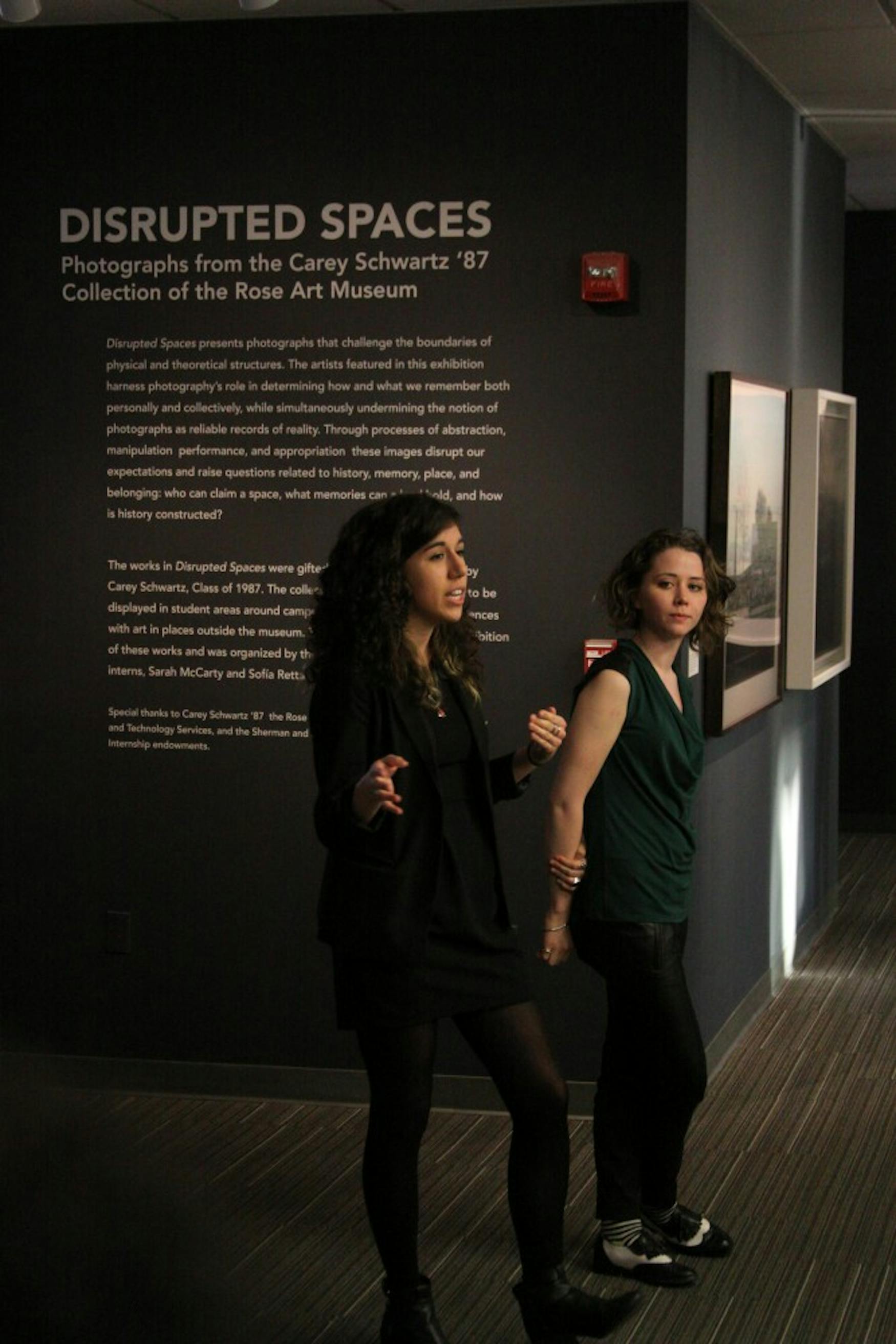Students explain creative choices in art exhibit
Rose Art Museum curatorial interns Sofia Retta ’15 and Sarah McCarty ’15 stated that they made sure to play to their strengths in organizing Disrupted Spaces, a photography exhibit focusing on memory and cultural history.
The pair spoke at an art talk on Thursday and described the choices they made during the curation process. A reception preceded the talk, which was help in the Farber Library Mezzanine. A group of 30 students, Brandeis staff and arts patrons gathered to celebrate the exhibit’s opening and listen to Retta and McCarty talk about their experience presenting the work.
Retta started the talk by explaining that the photographs belong to the Carey Schwartz ’87 Collection. As part of this collection, Schwartz stipulated that the works had to be displayed outside of the Rose Art Museum. The goal of this condition, Retta elaborated, is to expose students to artwork in everyday settings. Retta said that it was exciting to curate an exhibit outside the confines of the Rose’s walls.
McCarty stressed how nice it will be for students to be able to experience art outside of the Rose’s more restrictive hours.
In an Oct. 13, 2013 blog post titled “Farber Mezzanine (Upper Green) Renovated” by the Library and Technology Services blog, LTS mentioned that the goal of the Farber Mezzanine space was for “Brandeis students to have a social study space.”
The blog went on to say that the space was meant “to function as the student living room for campus—a place students feel is their own, and which reflects their interests and activities.” During the talk, McCarty reiterated this plan and mentioned that the exhibit’s conversation with the setting hopes to affect this type of relaxed atmosphere.
After the art talk, the interns opened up the floor to questions. When asked how they picked the works, Retta and McCarty stressed the differences between curating an exhibit inside versus outside of the Rose Art Museum.
McCarty noted that she and Retta picked a photography exhibit because they were interested in curating mediums that the Rose does not typically showcase. She said that professional photographs are vehicles rarely seen in student spaces, and this gave the project an exciting air of novelty.
In explaining how they chose the works, Retta mentioned that the small collection made her choices easier. She felt like the exhibit’s pieces were in dialogue naturally and did not need a unifying theme.
In response to a question about the exhibit’s title, the pair highlighted the title’s duality as the reason behind its applicability. Disrupted Spaces focuses on a variety of spaces—each photograph has a clear setting and an obvious historical, political or familial resonance for both the photographer and the viewer. While some pictures focused on regions in conflict, others highlighted the artists’ hometowns or places relevant to the artists’ backgrounds. McCarty said that Disrupted Spaces refers to the different ways all five of the artists represent and deal with these unique spaces.
She also noted the title’s irony; with its loud messages, the exhibit itself could be said to be disrupting the library’s traditionally quiet study space. Building on the theme of disruption, Retta emphasized how the artists disrupted the viewer’s expectations. Retta elaborated and said that while photos are usually seen as truthful, the exhibit complicates this assumption. With the photographs’ variety of settings, the photos can be said to represent spaces from a specific and even biased point of view.
The pair agreed that the most challenging part of working together was trying to jointly articulate the labels for the pieces. McCarty mentioned that they were more in contention with the label machine than with each other, but that making the labels did require a lot of dedication and editing.
Retta said that their goal in making the labels was to push the exhibit’s attendees to view the photos through a certain lens. This push has to be subtle, as Retta also mentioned that she wanted to leave viewers with the option to form their own opinions about the works and their meanings.
At the end of their talk, Retta said that she hopes that the social nature of the Mezzanine space will prompt students to look at the exhibit. Both interns mentioned that they are excited to hear feedback and that a book will be left in mezzanine for students so that students can record any comments they have about the photos.



Please note All comments are eligible for publication in The Justice.